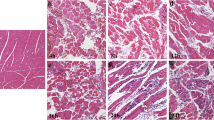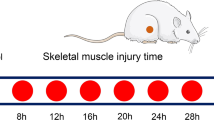Abstract
Gene expression profiling by quantitative real-time PCR (RT-qPCR) is a valuable tool in forensic science for estimating the age of a wound. To accurately assess gene expression levels over time in injured tissue, the genes used as internal reference standards must be carefully validated for transcriptional stability. This study examined the transcriptional stability of nine potential reference genes (β-actin, GAPDH, RPL32, PGK1, SDHA, RPL13, HPRT, Tbp, and Ywhaz) in contused rat skeletal muscle by RT-qPCR. The raw Ct values were determined for each candidate gene at different time points following contusion, and the data were analyzed by the NormFinder, geNorm, and BestKeeper validation programs. The reference genes RPL13 and RPL32 were the most stably expressed genes in contused skeletal muscle, whereas PGK1 was the least stable. The commonly used reference genes β-actin and GAPDH appeared to be too unstable for normalization of RT-qPCR expression profiling in contused muscle. The reference genes RPL13 and RPL32 were also the best combination for multianalysis. The use of RPL13 and RPL32 as internal standards may improve the accuracy of gene expression studies aimed at determining the age of early wounds in forensic investigations.





Similar content being viewed by others
References
Huggett J, Dheda K, Bustin S et al (2005) Real-time RT-PCR normalisation; strategies and considerations. Genes Immun 6(4):279–284
Partemi S, Berne PM, Batlle M et al (2010) Analysis of mRNA from human heart tissue and putative applications in forensic molecular pathology. Forensic Sci Int 203(1–3):99–105
Lindquist CD, Evans JJ, Wictum EJ (2011) Developmental validation of feline, bovine, equine, and cervid quantitative PCR assays. J Forensic Sci 56(Suppl (1)):S29–S35
Bustin SA, Nolan T (2004) Pitfalls of quantitative real-time reverse-transcription polymerase chain reaction. J Biomol Tech 15(3):155–166
Young NJ, Thomas CJ, Collins ME et al (2006) Real-time RT-PCR detection of bovine viral diarrhoea virus in whole blood using an external RNA reference. J Virol Methods 138(1–2):218–222
Wan G, Yang K, Lim Q et al (2010) Identification and validation of reference genes for expression studies in a rat model of neuropathic pain. Biochem Biophys Res Commun 400(4):575–580
Zampieri M, Ciccarone F, Guastafierro T et al (2010) Validation of suitable internal control genes for expression studies in aging. Mech Ageing Dev 131(2):89–95
Andersen CL, Jensen JL, Orntoft TF (2004) Normalization of real-time quantitative reverse transcription-PCR data: a model-based variance estimation approach to identify genes suited for normalization, applied to bladder and colon cancer data sets. Cancer Res 64(15):5245–5250
Vandesompele J, De Preter K, Pattyn F et al (2002) Accurate normalization of real-time quantitative RT-PCR data by geometric averaging of multiple internal control genes. Genome Biol 3(7):RESEARCH0034.1–0034.11
Pfaffl MW, Tichopad A, Prgomet C et al (2004) Determination of stable housekeeping genes, differentially regulated target genes and sample integrity: BestKeeper–Excel-based tool using pair-wise correlations. Biotechnol Lett 26(6):509–515
Sun JH, Wang YY, Zhang L et al (2010) Time-dependent expression of skeletal muscle troponin I mRNA in the contused skeletal muscle of rats: a possible marker for wound age estimation. Int J Legal Med 124(1):27–33
Yu TS, Cheng ZH, Li LQ et al (2010) The cannabinoid receptor type 2 is time-dependently expressed during skeletal muscle wound healing in rats. Int J Legal Med 124(5):397–404
Nelissen K, Smeets K, Mulder M et al (2010) Selection of reference genes for gene expression studies in rat oligodendrocytes using quantitative real time PCR. J Neurosci Methods 187(1):78–83
McBrier NM, Lekan JM, Druhan LJ et al (2007) Therapeutic ultrasound decreases mechano-growth factor messenger ribonucleic acid expression after muscle contusion injury. Arch Phys Med Rehabil 88(7):936–940
Radonic A, Thulke S, Mackay IM et al (2004) Guideline to reference gene selection for quantitative real-time PCR. Biochem Biophys Res Commun 313(4):856–862
Kobayashi T, Sasaki Y, Oshima Y et al (2006) Activation of the ribosomal protein L13 gene in human gastrointestinal cancer. Int J Mol Med 18(1):161–170
Berti R, Williams AJ, Moffett JR et al (2002) Quantitative real-time RT-PCR analysis of inflammatory gene expression associated with ischemia-reperfusion brain injury. J Cereb Blood Flow Metab 22(9):1068–1079
Curtis KM, Gomez LA, Rios C et al (2010) EF1alpha and RPL13a represent normalization genes suitable for RT-qPCR analysis of bone marrow derived mesenchymal stem cells. BMC Mol Biol 11:61
Tong Z, Gao Z, Wang F et al (2009) Selection of reliable reference genes for gene expression studies in peach using real-time PCR. BMC Mol Biol 10:71
Zhang X, Ding L, Sandford AJ (2005) Selection of reference genes for gene expression studies in human neutrophils by real-time PCR. BMC Mol Biol 6(1):4
Ahn K, Huh JW, Park SJ et al (2008) Selection of internal reference genes for SYBR green qRT-PCR studies of rhesus monkey (Macaca mulatta) tissues. BMC Mol Biol 9:78
Peters IR, Peeters D, Helps CR et al (2007) Development and application of multiple internal reference (housekeeper) gene assays for accurate normalisation of canine gene expression studies. Vet Immunol Immunopathol 117(1–2):55–66
Cappelli K, Felicetti M, Capomaccio S et al (2008) Exercise induced stress in horses: selection of the most stable reference genes for quantitative RT-PCR normalization. BMC Mol Biol 9:49
Selvey S, Thompson EW, Matthaei K et al (2001) Beta-actin–an unsuitable internal control for RT-PCR. Mol Cell Probes 15(5):307–311
Dheda K, Huggett JF, Chang JS et al (2005) The implications of using an inappropriate reference gene for real-time reverse transcription PCR data normalization. Anal Biochem 344(1):141–143
Acknowledgments
This study was financially supported by the National Science Foundation for Young Scientists of China (grant no. 81001347) and the Natural Science Foundation for Young Scientists of Shanxi Province, China (grant no. 2007021047).
Author information
Authors and Affiliations
Corresponding author
Rights and permissions
About this article
Cite this article
Sun, Jh., Nan, Lh., Gao, Cr. et al. Validation of reference genes for estimating wound age in contused rat skeletal muscle by quantitative real-time PCR. Int J Legal Med 126, 113–120 (2012). https://doi.org/10.1007/s00414-011-0604-3
Received:
Accepted:
Published:
Issue Date:
DOI: https://doi.org/10.1007/s00414-011-0604-3




